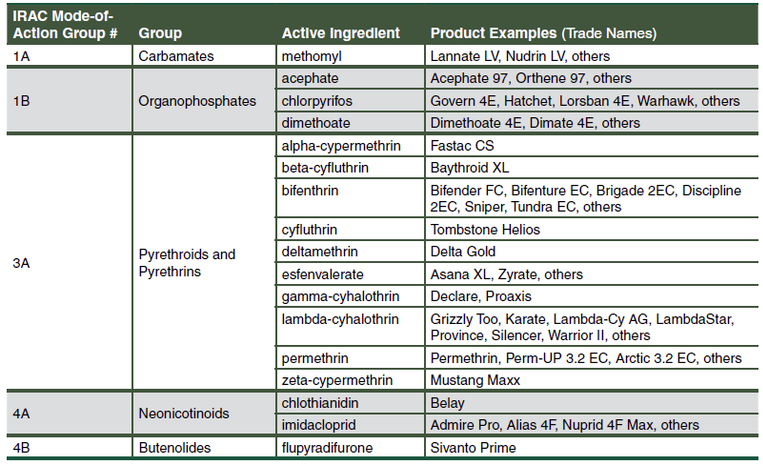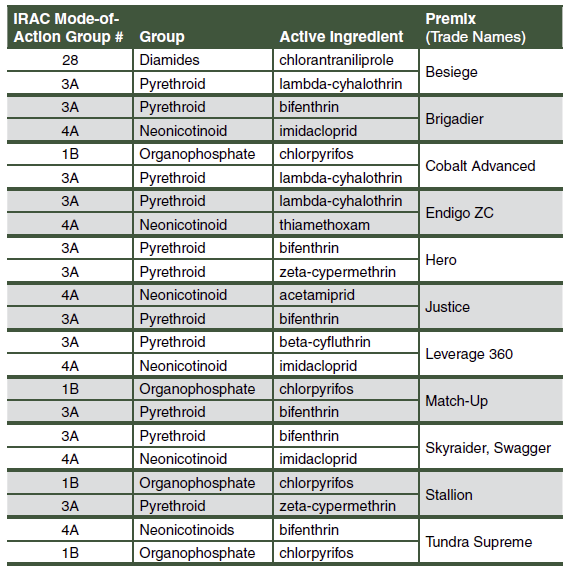Soybean aphids, Aphis glycines, are the most significant insect pest of soybean in Minnesota, Iowa, North Dakota and South Dakota. Development of insecticide resistance in this pest creates new challenges for effective soybean pest management and profitable soybean production.
Resistance is defined as a decrease in susceptibility of a pest population to an insecticide that may result in failures when the product is used according to label recommendations for that pest.
Failures of certain pyrethroid insecticides for management of some soybean aphid populations have been observed in commercial fields, and resistance to bifenthrin and lambda-cyhalothrin has been documented through small-plot research and laboratory bioassays. Because of the mobility of winged soybean aphids, the challenges posed by insecticide-resistant populations of the pest could spread to soybean fields in other parts of the region.
Management Strategies for Resistant Soybean Aphids
In response to the challenge that insecticide-resistant soybean aphids pose, we encourage growers, consultants and applicators to evaluate their soybean aphid management practices carefully. Best management practices include:
- Treat fields only when needed to reduce insecticide exposure to soybean aphids. This will reduce the selection pressure for further development of resistance.
- Fields should be scouted on a regular schedule (every seven to 10 days).
- Use the economic threshold (250 aphids per plant, with greater than 80% of plants infested) to determine when to apply insecticides.
- Treat within 5-7 days of exceeding the economic threshold to protect yield.
- If a field exceeds the threshold, make sure the insecticide is applied correctly.
- Use an effective (and labeled) insecticide at full labeled rate.
- Use proper nozzles, spray volume (15-20 gallons per acre by ground; 3-5 gallons per acre by air) and pressure (40 pounds per square inch).
- Spray under favorable environmental conditions to promote efficacy and reduce drift.
- After applications, scout fields again after three to five days to ensure the product provided the level of management expected.
- If a field needs to be retreated due to a failure, rotate to a different insecticide group for the follow-up application. Tables 1 and 2 list insecticide groups, active ingredients and example trade names of products available for soybean aphid management.
- For example, if a field was treated with a pyrethroid (Group 3A) and a follow-up insecticide application is needed, then an insecticide from different insecticide group, such as an organophosphate (Group 1B), should be selected.
- Mixtures of insecticides (premixes or formulated mixtures) may be effective for pest suppression but generally are not preferred for insecticide-resistance management.
- Insecticide seed treatments are not a viable answer to managing insecticide resistant aphid populations.
- Report suspected cases of insecticide-resistant soybean aphids to a local/regional Extension educator or Extension entomologist. Before assuming resistance, try to rule out other potential causes for an insecticide failure (such as incorrect rate or application method, or unfavorable environmental conditions).
Until aphid-resistant soybean varieties and other management tactics become more widely available, cost-effective management of soybean aphid will continue to rely on scouting and threshold-based insecticide applications of the few labeled insecticide groups (Table 1).
This short list of insecticide groups is under threat of becoming even shorter through continued development of pest resistance to insecticides and potential regulatory actions. The agricultural community would be wise to work together to preserve the effectiveness of and continued access to these important tools for protection of crops from insect pests.
Insecticide Resistance Factors
Factors that likely led to the development of insecticide resistance in soybean aphids:
- Frequent infestations – Economically threatening infestations of soybean aphid have occurred more frequently in portions of Minnesota and neighboring states than in other parts of the soybean aphid’s range, resulting in a long history of selection pressure for development of resistance.
- Limited number of insecticide groups for soybean aphid management (Table 1) – Management of soybean aphid has relied on foliar applications of only a few insecticide groups, mainly pyrethroids (Group 3A) and organophosphates (Group 1B), for more than 15 years.
- Misuse of insecticides can result in pests being exposed to insecticides more frequently, which further increases selection pressure. Examples of this include:
- Application of insecticides when pest populations are below economic threshold.
- Tank mixing insecticide with herbicide applications regardless of pest populations.
- Applying insecticides below the labeled rate.
- Repeated application of the same active ingredient or insecticide group within a single season.

Table 1. Foliar insecticides with single active ingredients labeled for soybean aphid management.

Table 2. Foliar insecticides with two or more active ingredients (often called premixes or formulated mixtures) labeled for soybean aphid management. Mixtures may be effective for pest suppression, but generally not preferred for insecticide resistance management.






Post a comment
Report Abusive Comment